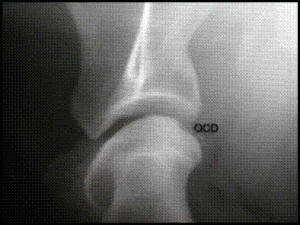OCD (or osteochondrosis dessicans) is an orthopedic condition where the cartilage of a developing joint matures abnormally. OCD can occur in any joint, but is especially common in the shoulders and elbows of young, large breed dogs.
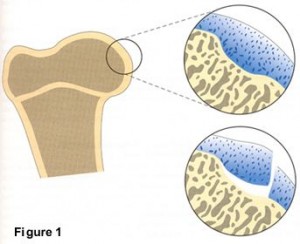
As a dog grows, cartilage is gradually replaced by bone, a process referred to as endochrondral ossification. With cases of OCD, this process is disturbed and the cartilage is not replaced by bone. Instead, it becomes abnormally thick and brittle and can sometimes detach from the bone underneath it. If a cartilage flap detaches, the fragment can “float” in the joint capsule and cause irritation, inflammation and pain.
Who gets OCD?
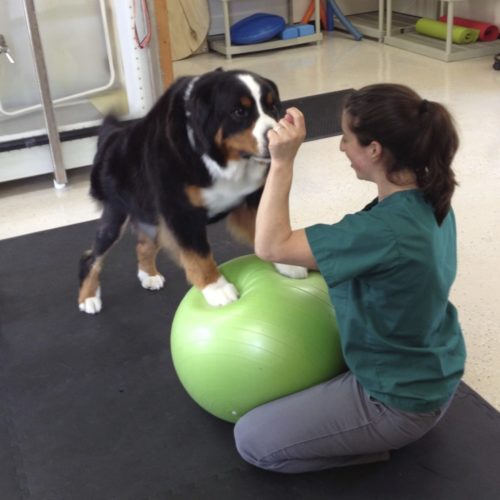
What are the Signs of OCD?
The most common clinical sign of OCD is lameness or soreness after intense exercise, and is often worse when getting up after a rest. One or multiple legs may be affected, and lameness can range from barely noticeable to complete non-weight bearing.
In some cases, there may be pain, heat, or swelling of the joints. Owners, handlers or veterinarians may notice shortened gait, reduced range of motion of the joint, and muscle atrophy due to disuse.
How is OCD Diagnosed?
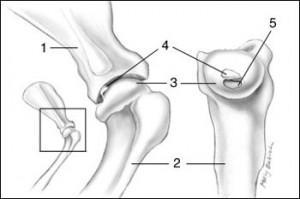
Because hyaline cartilage has no intrinsic mechanism for repair, any trauma, either acute or chronic, can cause injury to the cartilage, and lead to its separation. Repetitive microtrauma causes inflammation, osteonecrosis, vascular abnormalities, and extracellular matrix abnormalities. It can also cause damage to underlying blood supply, which triggers flap formation.
As the cartilage ossifies prematurely, it puts adjacent cartilage at risk of developing arthritis. There is also a genetic component to the disease and certain breeding lines are more predisposed to OCD than others. Because OCD occurs most during periods of rapid growth, nutrition also plays a role in the development of the disease. Diets that promote rapid growth, such as puppy foods high in calories and/or calcium, can increase the incidence of OCD. This is one of the most important rationales for feeding “large breed” foods to young large breed dogs. The severity of OCD symptoms are positively correlated with age, weight, humeral head size, and BCS, so it is important to prevent puppies from becoming overweight.
How is OCD Treated?
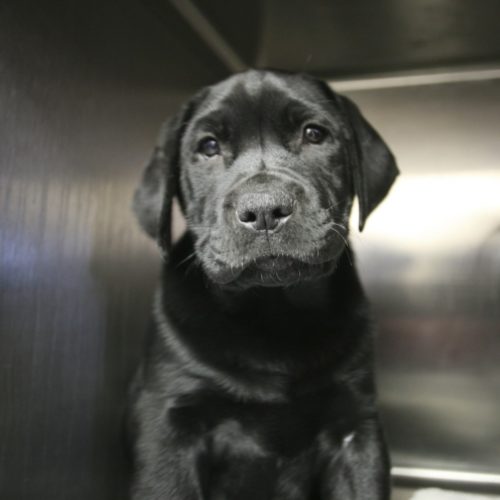
If detected early, OCD lesions can be addressed conservatively with rest and a restricted diet lower in calories and in calcium. (Make sure to consult your veterinarian before changing your pet’s diet.) Some patients may be prescribed non-steroidal anti-inflammatories (NSAIDs) or other pain medications. Rehabilitation therapy including acupuncture, cryotherapy, hydrotherapy and gentle manual and therapeutic exercises can reduce traumatic forces on the joint, modulate inflammation, and ideally prevent the damaged cartilage from breaking off.
Modalities such as LASER, therapeutic Ultrasound, Shockwave therapy and PEMF have also been shown to assist with circulation, pain control and cartilage regeneration. Goals of therapy include pain relief, improved function and slowing the development of arthritis. In severe cases where the thickened cartilage flap has detached, or where the lameness is not resolving with conservative management, surgery may be indicated. Highly active dogs may also be candidates for surgery. Surgical options include arthroscopic removal of the cartilage flap through a small incision, or arthrotomy (open joint) surgery. Arthroscopy is considered the gold standard of treatment because it allows full examination of all joint compartments. In some cases, platelet rich plasma or stem cells are incorporated into surgical procedures. Rehabilitation therapy is highly recommended after any surgical procedure for OCD, as are dietary supplements like omega fatty acids and glucosamine.
How is OCD Prevented?
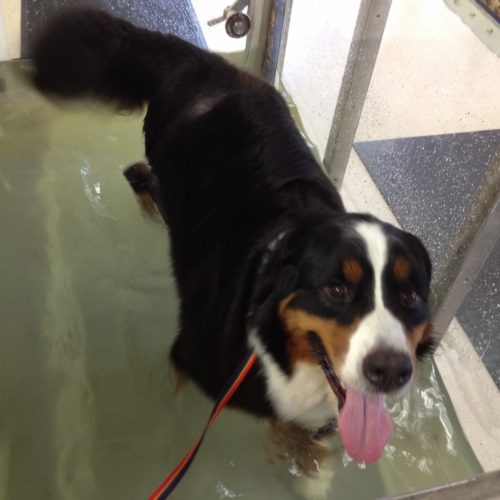
Osteochondritis Dessicans can be prevented by careful, selective breeding, taking precautions not to perpetuate the genetics of animals with a history of OCD. Large breed dogs should be fed a balanced diet to promote slow bone growth. Strenuous activity should also be avoided in young, growing dogs until the growth plates close (around 18-24mos.) Feel free to contact Dr. Barsky and Two Hands Four Paws with any questions about OCD or any other musculoskeletal disorder. With OCD and other disorders, prevention is always the best treatment!

